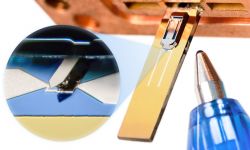
Scientists around the world are working to demonstrate the quantum nature of macroscopic objects in the laboratory and to exploit it. Physicists led by Gerhard Kirchmair have now succeeded in coupling a micromechanical oscillator magnetically strongly to a superconducting circuit. In the future, the limits of the quantum world could thus be explored and new quantum sensors built.
The laws of the quantum world are so different from those in the world observable by humans. For this reason, science has long been fascinated by the question of where the border between these two worlds lies. One way to determine this is to cool a macroscopic object consisting of a large number of atoms to such an extent that it obeys the rules of quantum physics. Similar to the laser cooling of atoms, optical systems are also used to cool mechanical objects. Such optomechanical experiments have already achieved considerable success in recent years. In 2015, the Innsbruck physicists Oriol Romero-Isart and Gerhard Kirchmair presented a new approach in which the mechanical object is not coupled to a superconducting circuit via electric fields but with a magnetic field. Now the team led by Gerhard Kirchmair at the Institute of Quantum Optics and Quantum Information (IQOQI) of the Austrian Academy of Sciences and the Department of Experimental Physics at the University of Innsbruck has succeeded in implementing this idea in the laboratory and has coupled a micromechanical oscillator to a superconducting circuit in such a way that even a single photon can cool the macroscopic object.
Photon cools oscillator
For the experiment, the physicists attached a magnet to the tip of an approximately 100 micrometer wide mechanical oscillator. "When the mechanical oscillator moves, it changes the magnetic flux through a superconducting circuit," explains Gerhard Kirchmair. At the heart of this superconducting circuit is a so-called SQUID, a superconducting quantum interferometer that changes its resonant frequency when the flux changes. "We can then detect this with the help of microwave signals," explain David Zöpfl and Mathieu Juan, the two first authors of the work, which has now been published in the journal Physical Review Letters. "The extraordinary aspect of this experiment is that we achieve a particularly strong coupling between mechanics and circuitry." The coupling is so strong that with only a single photon - averaged over the lifetime of the microwave resonator - the resonator can be cooled down. "To put it crudely, a single microwave photon can change the state of the massive oscillator, which weighs several tens of nanograms," says Gerhard Kirchmair, illustrating the important result.
The work was financially supported by the Austrian Science Fund FWF and the European Union.